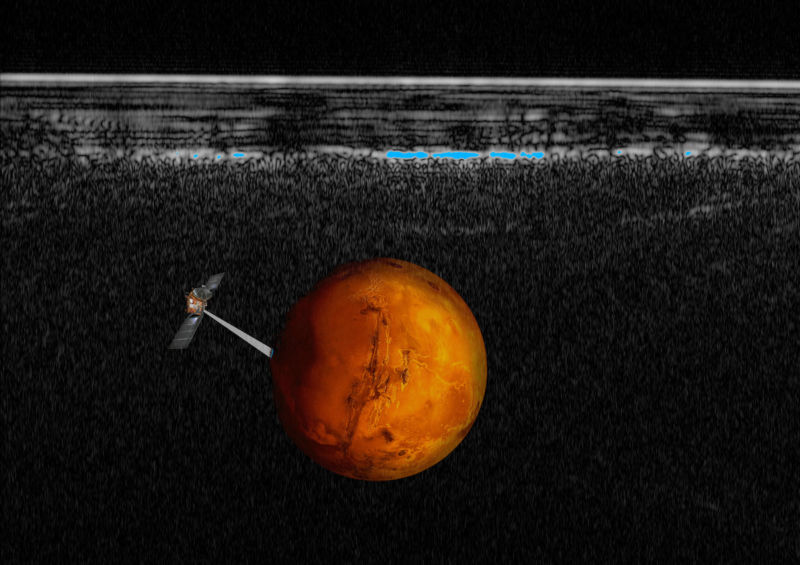
Today, a team of Italian scientists announced evidence that Mars has lakes of liquid water under its polar ice caps. While the evidence is a bit indirect and requires a number of assumptions, the alternatives that the researchers have considered fit the data worse. The announcement is likely to get scientists thinking about how to use existing instruments orbiting Mars to give this region a more careful examination.
Under the poles
Most parts of Mars spend much of the time at temperatures too low to support liquid water at the surface. Adding salt—and we’ve found lots of evidence of salt on Mars—can lower the freezing point of water by turning it into a brine. But that’s not enough to overcome the extremely low pressures of the Martian atmosphere, which would cause any ice to sublimate off into vapor instead of melting.
So the only realistic hope for significant amounts of liquid water is under the surface, at sufficient depth to create enough pressure to allow salt to overcome the low temperatures. Calculations have suggested that these conditions may be met at the Martian poles, where large ice caps composed of both water and frozen carbon dioxide exist. There are obvious parallels to Antarctica, where lakes have been discovered beneath glaciers in several areas of the otherwise frozen continent.
But so far, no clear evidence of liquid water has turned up, but the new evidence gives some strong hints that it might be there.
The data comes from the ESA’s Mars Express orbiter, which carries a ground-penetrating radar instrument called MARSIS. Subsurface imaging relies on the fact that borders between materials with different properties will bounce back a portion of the incoming radar signal. So while a layer of ice and a layer of rock may both be weakly reflective, the boundary that occurs when ice sits on top of rocks will create a strong reflection that can be detected by an orbiting radar. The interface between ice and water acts similarly, producing a bright reflection.
MARSIS now has generated roughly 13 years of data, including multiple passes over the polar regions. Analysis of that data had already identified a highly reflective region beneath the thickest part of the southern ice cap in an area called the Planum Australe. But that feature had been ascribed to a boundary between the dust-containing ice that dominates Mars’ surface and a layer of pure water ice that is expected to exist below that. For this study, the Italian researchers revisited that assumption and attempted to determine if pure water ice was consistent with the radar data.
Opening windows
For their study, they would ideally use the radar signal to measure the material properties of the layer, which would determine how well radar signals could travel through it. The process requires a detailed understanding of the radar signals that were transmitted downward toward Mars by Mars Express. And unfortunately, we don’t have that understanding—the instrument was simply too large to open it up and calibrate it on the ground before Mars Express was launched.
So the researchers did a rough calibration by registering the signal that bounced back when the radar hit the atmosphere/dusty ice boundary at the Martian surface, since the composition of these materials is pretty well understood. Combined with calculated temperatures at different depths, that calibration allowed the researchers to calculate a value for the reflections occurring at deeper levels. While there are significant uncertainties associated with these values, they were used to estimate a window in which the actual value probably resided.
Conveniently, the full range of these windows was above that of any material previously seen on Mars. In other words, even the lowest likely value was above the highest value we’ve observed previously. And similar values on Earth are typically only generated by materials that are wet or liquid. In the Antarctic, all similar values have been associated with liquid water. And if you try the same technique on areas outside the highly reflective ones, it produces values that are similar to those of dry volcanic rock on Earth.
Lake or pancake?
There are other possible explanations for this sort of signal, but the authors consider and reject them. To give one example, they consider a layer of carbon dioxide that was liquified by the pressure. While this layer could form under the conditions present at the base of the ice cap, its properties are such that you wouldn’t get such a strong reflection. Other conditions they consider would produce similar reflections but are unlikely to be found under a 1.5km thick sheet of ice.
It’s tempting to think of this feature as a lake, given that the area with high reflectivity is several kilometers in diameter. But the radar reflections could be produced by a layer of water less than a meter thick, so it could be just a thin layer of liquid lining the base of the ice sheet. And again, the liquid involved would be far saltier than Earth’s oceans (and the salts are likely perchlorates, which aren’t as common on Earth).
Before we get too excited about drilling 1.5km into the poles of Mars to look for ice, however, we’ll probably want independent confirmation that this high-reflectivity region shows up consistently and behaves as if it’s liquid water. Conveniently, there’s another radar instrument called SHARAD orbiting the Red Planet on the Mars Reconnaissance Orbiter. SHARAD operates at different frequencies than MARSIS does, but it’s also designed to pick up subsurface features.
Obviously, if the results hold up, they would have a big impact on how we think about the prospects of life existing on Mars. While a frozen, salty, high-pressure environment with no obvious energy input isn’t a great place for life to have arisen, it’s possible that a previously formed ecosystem could scrape by using some chemical energy scavenged from the underlying rocks—we have examples of that process on Earth.

